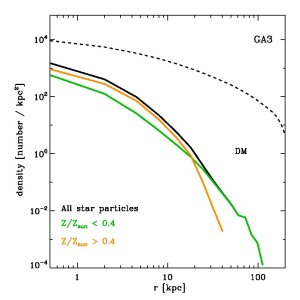|
|  |
Our own Galaxy - the Milky Way - is a fairly large spiral galaxy
consisting of four main stellar components: (1) the thin disk, that contains
most of the stars in the galaxy, with a wide range of ages and on high angular
momentum orbits; (2) the thick disk, that contains about 10-20 % of the
mass in the thin disk and whose stars are on average older and contain less
metals than those in the thin disk; (3) the bulge, which contains old and metal
rich stars on low angular momentum orbits; and (4) the stellar halo which
contains only a few % of the total stellar mass and whose stars are old
and metal poor and reside on low angular momentum orbits.
Researchers Gabriella De Lucia (MPA) and Amina Helmi (Kapteyn Astronomical
Institute) have studied the formation of the Milky Way and of its stellar
halo by combining high-resolution N-body simulations with semi-analytic models
of galaxy formation
( Research Highlight May 2004). In
these models, galaxies are assumed to form when gas condenses at the centre of
dark matter haloes whose location and evolution is followed by taking advantage
of the N-body simulation. The evolution of the baryonic components of galaxies
(e.g. gas, stars, metals) is then "painted" on top of the history of dark
matter haloes by adopting simple analytic prescriptions that are supported by
observational data and/or theoretical arguments. Research Highlight May 2004). In
these models, galaxies are assumed to form when gas condenses at the centre of
dark matter haloes whose location and evolution is followed by taking advantage
of the N-body simulation. The evolution of the baryonic components of galaxies
(e.g. gas, stars, metals) is then "painted" on top of the history of dark
matter haloes by adopting simple analytic prescriptions that are supported by
observational data and/or theoretical arguments.
The physical properties of our model Milky Way are in quite nice agreement with
observational measurements for our Galaxy. Fig.1 shows, for example, the
distribution of ages and metallicities for all stars (left panel) and for stars
in the spheroidal component (right panel) of the model Milky Way. The Figure
shows that the Galaxy contains stars of all ages - which means they were
produced on a long time-scale - but covering a limited range in metal
content. In contrast, the stars in the spheroidal component all have old ages
and a few of them have relatively low metallicities, in qualitative agreement
with observational measurements.
In order to study the structure and metallicity distribution of the stellar
halo, we assume that it builds up from the cores of the satellite galaxies that
merged with the Milky Way over its lifetime. Fig.2 shows the projected
distribution of the star particles that end up in the stellar halo, at
different cosmic epochs. The star particles are colour coded as a function of
their metal content, as indicated in the leftmost panel. The Figure shows that
the star particles that end up in the stellar halo extend over a projected
region of ~1 Mpc2 at z ~10. At z ~1, the star particles are
already assembled in a single relatively elongated component which
becomes progressively more spherical with decreasing redshift.
The rightmost panel of Fig.2 shows that there is no clear correlation between
metallicity and distance from the centre of the stellar halo (i.e. no clear
metallicity gradient), with low and high metallicity stars distributed at
various distances. High metallicity stars are, however, more centrally
concentrated than stars of low metallicity. This is shown more explicitly in
Fig.3 which shows the projected density profile of the stellar halo (black),
and of stars with metallicity larger (orange) and lower (green) than 0.4 times
the solar value respectively. The probability of observing low-metallicity
stars therefore increases at larger distances from the Galactic centre
(> ~10-20 kpc) where the contribution from the inner more metal-rich stars is
less dominant. The stronger concentration of high metallicity stars is due to
the fact that the building blocks of the stellar halo lie on a well defined
mass-metallicity relation, and that they are dragged closer to the inner
regions of the halo by dynamical friction.
The numerical resolution of the simulations used in our study is too low for
studies of spatially and kinematically coherent stellar streams in the present
day stellar halo. Higher resolution simulations
( Press Release November 2008)
are needed for these studies. These are all much
needed steps to interpret the outcome of ongoing and future large surveys such
as SEGUE, RAVE and ultimately GAIA, with the goal of unrevealing the
evolutionary history of our Galaxy. Press Release November 2008)
are needed for these studies. These are all much
needed steps to interpret the outcome of ongoing and future large surveys such
as SEGUE, RAVE and ultimately GAIA, with the goal of unrevealing the
evolutionary history of our Galaxy.
Gabriella De Lucia
Further information:
Gabriella De Lucia and Amina Helmi,
The Galaxy and its stellar halo: insights
on their formation from a hybrid cosmological approach,
MNRAS in press,
 arXiv0804.2465 arXiv0804.2465
|






